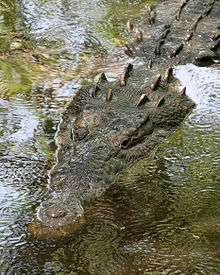Crocodylidae
| Crocodylids Temporal range: Eocene - Recent, 55–0 Ma | |
|---|---|
 | |
| C. palustris | |
| Scientific classification | |
| Kingdom: | Animalia |
| Phylum: | Chordata |
| Class: | Reptilia |
| Superorder: | Crocodylomorpha |
| Order: | Crocodilia |
| Family: | Crocodylidae Cuvier, 1807 |
| Subfamilies | |
The Crocodylidae family of crocodylians includes the true crocodiles which are the members of the subfamily Crocodylinae and the Tomistoma genus. Currently, the family includes two subfamilies, Crocodylinae and Tomistominae, with the latter being a subject of controversy whether it is a crocodile or belongs to the family Gavialidae.[1] Further genetic analysis has to be done to come to a final conclusion.
Taxonomy
A total of three extant genera are placed in the family Crocodylidae, including a total of 15 species, including the desert crocodile, which is now accepted as a true species rather than a subspecies of the Nile crocodile. Recent studies suggest the dwarf crocodile, Osteolaemus tetraspis, is not a single, but two or even three species.[2] If so, the species count of extant crocodiles would be 16 or 17, putting the extant crocodylian species to a total of 26 instead of 24.
True crocodiles
The two extant genera of true crocodiles, Crocodylus and Osteolaemus, are in the subfamily Crocodylinae. Even according to traditional classification, the Tomistoma is not a true crocodile, though it is a member of the family Crocodylidae. Latest molecular evidence points to an even greater difference, creating the possibility that in fact Tomistoma is genetically closer to the gharial than true crocodiles. If proven, the species will be classified under the family Gavialidae.[1]
Their most obvious external differences from alligators are visible in the head. Crocodiles have narrower and longer heads, and more V-shaped than U-shaped snouts. The alligator's upper jaw is wider than its lower jaw, and the teeth in the lower jaw fit into small depressions in the upper jaw. The upper and lower jaws of the crocodiles are the same width, and teeth in the lower jaw fall along the edge or outside the upper jaw when the mouth is closed. When the crocodile's mouth is closed, the large fourth tooth in the lower jaw fits into a constriction in the upper jaw. For hard-to-distinguish specimens, the protruding tooth is the most reliable feature to define a species.
Crocodylidae
Most species are grouped into the genus Crocodylus. The other extant genus, Osteolaemus, is monotypic (as is Mecistops, if recognized).
- Family Crocodylidae
- Subfamily †Mekosuchinae (extinct)
- Subfamily Crocodylinae
- Genus Crocodylus
- Crocodylus acutus, American crocodile
- Crocodylus cataphractus, slender-snouted crocodile (studies in DNA and morphology suggest this species may be more basal than Crocodylus, so belongs in its own genus, Mecistops).[3]
- Crocodylus intermedius, Orinoco crocodile
- Crocodylus johnsoni, freshwater crocodile, or Johnstone's crocodile
- Crocodylus mindorensis, Philippine crocodile
- Crocodylus moreletii, Morelet's crocodile or Mexican crocodile
- Crocodylus niloticus, Nile crocodile or African crocodile (the subspecies found in Madagascar is sometimes called the black crocodile)
- Crocodylus novaeguineae, New Guinea crocodile
- Crocodylus palustris, mugger, marsh or Indian crocodile
- Crocodylus porosus, saltwater crocodile or estuarine crocodile
- Crocodylus rhombifer, Cuban crocodile
- Crocodylus siamensis, Siamese crocodile (may be extinct in the wild)
- Crocodylus suchus, West African crocodile, desert or sacred crocodile
- Genus Osteolaemus
- Osteolaemus tetraspis, dwarf crocodile (There has been controversy as to whether or not this is actually two species; recent (2010) DNA analysis indicate three distinct species: O. tetraspis, O. osborni and a third, currently unnamed.)
- Genus †Euthecodon
- Genus †Rimasuchus (formerly Crocodylus lloydi)
- Genus †Voay Brochu, 2007 (formerly Crocodylus robustus)
- Genus Crocodylus
Phylogeny
The cladogram below follows the topology from a 2012 analysis of morphological traits by Christopher A. Brochu and Glenn W. Storrs. Many extinct species of Crocodylus might represent different genera. C. suchus was not included because its morphological codings were identical to those of C. niloticus. However, the authors suggested that it could be explained by their specimen sampling, and considered the two species to be distinct.[4]
References
- 1 2 Gatesy, Jorge; Amato, G.; Norell, M.; DeSalle, R.; Hayashi, C. (2003). "Combined support for wholesale taxic atavism in gavialine crocodylians" (PDF). Systematic Biology. 52 (3): 403–422. doi:10.1080/1063515035019703.
- ↑ Eaton, Mitchell J.; Andrew Martin; John Thorbjarnarson; George Amato (March 2009). "Species-level diversification of African dwarf crocodiles (Genus Osteolaemus): A geographic and phylogenetic perspective". Molecular Phylogenetics and Evolution. 50 (3): 496–506. doi:10.1016/j.ympev.2008.11.009.
- ↑ McAliley, Willis, Ray, White, Brochu & Densmore (2006). Are crocodiles really monophyletic?—Evidence for subdivisions from sequence and morphological data. Molecular Phylogenetics and Evolution 39:16–32.
- ↑ Brochu, C. A.; Storrs, G. W. (2012). "A giant crocodile from the Plio-Pleistocene of Kenya, the phylogenetic relationships of Neogene African crocodylines, and the antiquity of Crocodylus in Africa". Journal of Vertebrate Paleontology. 32 (3): 587. doi:10.1080/02724634.2012.652324.
